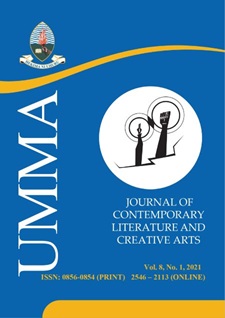Crux of the Bongo Movie from a Digital Disruption Lens
Abstract
This paper reports the findings of a study that had explored digital disruption as an analytical lens developed based on the constructs of two theories: the digital disruption theory and the disruptive innovation theory. The study had employed unstructured in-depth interviews, direct observation and virtual ethnographic to consult media experts, pioneer filmmakers, Bongo Movie ' producers, movies library ' s keepers, movie retailers, movie translators (deejays) and social network sites (SNS) to collect data. Based on the study findings, the paper argues that the shift in technological paradigm, specifically from the use of expensive and inaccessible technologies used in filmmaking engendered the development and sustainability of the Bongo Movie genre in Tanzania. This technological paradigm shifts were twofold. To begin with, there was a transition from the use of celluloid film and analogue video cameras to digital video cameras in film production. Second, there was a shift from the use of optical prints and Vertical Helican Scan (VHS) tapes to optical discs such as Digital Versatile Discs (DVD) in the distribution of films. These changes in the technologies used in production and distribution of films provided entrants into the local film industry with necessary tools to produce low-budget films and service the low-end market of the country, which augured well with the country ' s resource-poor context. Moreover, these Bongo Movies "disrupted" the erstwhile traditional, established, and stringent patterns of consumption of both locally-produced and foreign-imported films in local film markets. Overall, the Bongo Movie genre evolution appears to be a model of how digitally-motivated disruptions can occur in a local film market in a developing nation ' s video-film industries and become a staple particularly among the low-end clientele. https://dx.doi.org/10.56279/ummaj.v9i2.4
References
Ailisto, H, Kalevi K. Mantlya M, Karhu K & Hammainen H. 2018, A disruption framework, iTechnological Forecast and Social Change Journal. vol. 129, pp. 275-284.
Benghozi, P. J, & Paris, T. 2016, The cultural economy in the digital age: A revolution in intermediation? City, Culture and Society, vol.7. pp.75-80.
Bisschoff, L & Overbergh A, 2012, Digital as the new popular in African Cinema? case studies from the continent, Research in African Literatures, vol. 43, no. 4, pp. 112-127.
Christensen, C. M, Raynor, M.E, & McDonald, R. 2015, What is disruptive innovation? Harvard Business Review, pp. 44 €“ 53.
Christensen, C. M. (1997). The innovator's dilemma: When new technologies cause great firms to fail, Harvard Business School Press, Cambridge, MA.
Fulton, D., Fulton, R., & Garsombke, M. 2015, Shifting technology paradigm for the film and entertainment industry; interface modalities. Journal of Technology Research, Vol. 6.
Harding, F. 2007, Appearing fabulous: From tender romance to horrifying sex, in Okome O. (Ed). Welcome to Nollywood. Africa Visualizes. Film International, vol.5, no 28, 4.
Hill, J.B. (Ed). 2017, Leading through digital disruption. Gartner Insights on spotting and responding to digital disruption. https://www.gartner.com/imagesrv/books/digitaldisruption/pdf/digital_disruption_ebook.pdf
Hopkins, D. 2018, The 6 Ds of film industry disruption: discover how the film industry is being disrupted today. https://www.linkedin.com/pulse/6-ds-film-industry-disruption-discover-how-being-today-hopkins.
Krings, M. 2010, Nollywood goes east: the localization of Nigerian video films in Tanzania, in Saul M and Austen R.A (Eds), Viewing African Cinema in the Twenty-First Century, Ohio University Press. USA.
Krings, M. 2014, Turning rice into pilau: the art of video narration in Tanzania, in Krings & Reuster-Jahn. (Eds), Bongo Media Worlds: An introduction, Druckerei Hubert & Co. Germany.
Mwakalinga, M. N. 2016, Looking at Tanzania video films through a transnational lens., Journal of Humanities, vol. 3, no. 1, pp. 39 €“ 47.
Mwakalinga, M. N. (2011). The political economy of the film industry in Tanzania, Phd Thesis, University of Kansas.
Orlando, K.V. 2017, Quick takes: movies & popular culture. New African Cinema, Rutgers University Press , New Jersey, USA.
Skog, D, Wimelius, H, & Sandberg, J. 2018, Digital disruption, Business & Information Systems Engineering. https://www.researchgate.net/publication. Oxford University Press.
Stewart, B, Schatz, R & Khare, A. 2017, Making sense of digital disruption using a conceptual two-order model. https://www.researchgate.net/publication.
Shule V. 2014, Reading beyond statistics: the contribution of Kiswahili video film industry in the Tanzanian economy, Creative Artists: A Journal of Theatre and Media Studies, vol. 8, no. 1, pp. 1-15.
Downloads
Published
Issue
Section
License
- Authors retain copyright and grant the journal right of first publication with the work simultaneously licensed under a Creative Commons Attribution License that allows others to share the work with an acknowledgement of the work's authorship and initial publication in this journal.
- Authors are able to enter into separate, additional contractual arrangements for the non-exclusive distribution of the journal's published version of the work (e.g., post it to an institutional repository or publish it in a book), with an acknowledgement of its initial publication in this journal.
- Authors are permitted and encouraged to post their work online (e.g., in institutional repositories or on their website) prior to and during the submission process, as it can lead to productive exchanges, as well as earlier and greater citation of published work (See The Effect of Open Access).



